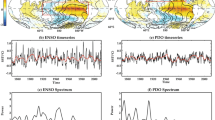Abstract
In this study, the persistence barrier (PB) of the El Niño–Southern Oscillation (ENSO) phenomenon is investigated using reanalysis data and historical simulations of the Coupled Model Intercomparison Project Phase 5 (CMIP5) models. Both the timing and intensity of the ENSO PB can be quantified using the maximum gradient of autocorrelation decline of Niño sea surface temperature (SST) anomaly indices. Most of the CMIP5 models were found to reasonably reproduce the observed timing of the ENSO PB that typically occurs during the boreal late spring to early summer, and underestimated the PB intensity compared to observations. Furthermore, the PB properties of the Eastern Pacific (EP) ENSO indices were much better represented by the models than those of the Central Pacific (CP) ENSO indices, probably because CP ENSO events are more challenging to simulate than their counterparts. Approximately half of the models can satisfyingly reflect the intensity and timing of PB for indices of EP ENSO and their distinctions from those of the CP ENSO, with a larger uncertainty for the modeled PB timing than intensity. Further diagnosis has revealed the relationship between the ENSO PB intensity and the factors associated with the tropical Pacific background state. The PB intensity exhibits a stronger relationship with the seasonality of the SST amplitude in CP, compared to the SST amplitude, and the strength of seasonal synchronization of EP SST anomalies is highly correlated with the PB intensity. These results suggest that the seasonality of tropical SST variability may fundamentally contribute to the ENSO PB.











Similar content being viewed by others
References
Ashok K, Behera SK, Rao SA, Weng H, Yamagata T (2007) El Niño Modoki and its possible teleconnection. J Geophys Res. https://doi.org/10.1029/2006JC003798
Barnett TP et al (1994) Forecasting global ENSO-related climate anomalies. Tellus A 46:381–397
Barnston AG, Tippett MK, L’Heureux ML, Li S, DeWitt DG (2012) Skill of real-time seasonal ENSO model predictions during 2002–11: is our capability increasing? B Am Meteorol Soc 93:631–651. https://doi.org/10.1175/bams-d-11-00111.1
Bellenger H, Guilyardi E, Leloup J, Lengaigne M, Vialard J (2014) ENSO representation in climate models: from CMIP3 to CMIP5. Clim Dyn 42:1999–2018. https://doi.org/10.1007/s00382-013-1783-z
Chang P et al (2007) Pacific meridional mode and El Niño–Southern Oscillation. Geophys Res Lett 34:130–144. https://doi.org/10.1029/2007gl030302
Chen D, Zebiak SE, Busalacchi AJ, Cane MA (1995) An improved procedure for El Nino forecasting: implications for predictability. Science 269:1699–1702
Chen D et al (2015) Strong influence of westerly wind bursts on El Niño diversity. Nat Geosci 8:339–345. https://doi.org/10.1038/ngeo2399
Chiang JCH, Vimont DJ (2004) Analogous Pacific and Atlantic meridional modes of tropical atmosphere–ocean variability. J Clim 17:4143–4158
Duan W, Liu X, Zhu K, Mu M (2009) Exploring the initial errors that cause a significant “spring predictability barrier” for El Niño events. J Geophys Res 114:C04022. https://doi.org/10.1029/2008jc004925
Duan W, Tian B, Xu H (2014) Simulations of two types of El Niño events by an optimal forcing vector approach. Clim Dyn 43:1677–1692. https://doi.org/10.1007/s00382-013-1993-4
Ham Y-G, Kug J-S (2012) How well do current climate models simulate two types of El Nino? Clim Dyn 39:383–398. https://doi.org/10.1007/s00382-011-1157-3
Ham Y-G, Kug J-S, Kim D, Kim Y-H, Kim D-H (2012) What controls phase-locking of ENSO to boreal winter in coupled GCMs? Clim Dyn 40:1551–1568. https://doi.org/10.1007/s00382-012-1420-2
Harrison DE, Vecchi GA (1999) On the termination of El Niño. Geophys Res Lett 26:1593–1596. https://doi.org/10.1029/1999gl900316
Hendon HH, Lim E, Wang G, Alves O, Hudson D (2009) Prospects for predicting two flavors of El Niño. Geophys Res Lett. https://doi.org/10.1029/2009gl040100
Hu Z-Z, Kumar A, Jha B, Wang W, Huang B, Huang B (2011) An analysis of warm pool and cold tongue El Niños: air–sea coupling processes, global influences, and recent trends. Clim Dyn 38:2017–2035. https://doi.org/10.1007/s00382-011-1224-9
Jin EK et al (2008) Current status of ENSO prediction skill in coupled ocean–atmosphere models. Clim Dyn 31:647–664. https://doi.org/10.1007/s00382-008-0397-3
Kalnay E et al (1996) The NCEP/NCAR 40-year reanalysis project B. Am Meteorol Soc 77:437–471
Kanamitsu M, Ebisuzaki W, Woollen J, Yang S, Hnilo JJ, Fiorino M, Potter GL (2002) NCEP-DOE AMIP-II Reanalysis (R-2) B. Am Meteorol Soc 83:1631–1643. https://doi.org/10.1175/bams-83-11
Kao H-Y, Yu J-Y (2009) Contrasting Eastern-Pacific and Central-Pacific types of ENSO. J Clim 22(3):615–632. https://doi.org/10.1175/2008JCLI2309.1
Kim ST, Yu J-Y (2012) The two types of ENSO in CMIP5 models. Geophys Res Lett 39:221–228. https://doi.org/10.1029/2012gl052006
Kug J-S, Jin F-F, An SI (2009) Two types of El Niño events: cold tongue El Niño and warm pool El Niño. J Clim 22(6):1499–1515. https://doi.org/10.1175/2008JCLI2624.1
Larson SM, Kirtman BP (2016) Drivers of coupled model ENSO error dynamics and the spring predictability barrier. Clim Dyn 48:3631–3644. https://doi.org/10.1007/s00382-016-3290-5
Latif M et al (1994) A review of ENSO prediction studies. Clim Dyn 9:167–179
Levine AFZ, McPhaden MJ (2015) The annual cycle in ENSO growth rate as a cause of the spring predictability barrier. Geophys Res Lett 42:5034–5041. https://doi.org/10.1002/2015gl064309
Lloyd J, Guilyardi E, Weller H, Slingo J (2009) The role of atmosphere feedbacks during ENSO in the CMIP3 models. Atmos Sci Lett 10:170–176. https://doi.org/10.1002/asl.227
Lopez H, Kirtman BP (2015) WWBs, ENSO predictability, the spring barrier and extreme events. J Geophys Res Atmos 119:10114–10138. https://doi.org/10.1002/2014jd021908
McPhaden MJ (2012) A 21st century shift in the relationship between ENSO SST and warm water volume anomalies. Geophys Res Lett. https://doi.org/10.1029/2012gl051826
Mu M, Xu H, Duan W (2007) A kind of initial errors related to “spring predictability barrier” for El Niño events in Zebiak-Cane model. Geophys Res Lett 34:L03709. https://doi.org/10.1029/2006gl027412
Rasmusson EM, Carpenter TH (1982) Variations in tropical sea surface temperature and surface wind fields associated with the Southern Oscillation/El Nino. Mon Weather Rev 110:354–384
Rayner NA (2003) Global analyses of sea surface temperature, sea ice, and night marine air temperature since the late nineteenth century. J Geophys Res 108:1063–1082. https://doi.org/10.1029/2002jd002670
Ren HL, Jin FF (2011) Nino indices for two types of ENSO. Geophys Res Lett 38:L04704. https://doi.org/10.1029/2010gl046031
Ren HL, Liu Y, Jin FF, Yan YP, Liu XW (2014) Application of the analogue-based correction of errors method in ENSO prediction. Atmos Ocean Sci Lett 7:157–161. https://doi.org/10.3878/j.issn.1674-2834.13.0080
Ren H-L, Jin F-F, Tian B, Scaife AA (2016) Distinct persistence barriers in two types of ENSO. Geophys Res Lett 43:10973–10979. https://doi.org/10.1002/2016gl071015
Smith TM, Reynolds RW, Peterson TC, Lawrimore J (2008) Improvements to NOAA’s historical merged land–ocean surface temperature analysis (1880–2006). J Clim 21:2283–2296. https://doi.org/10.1175/2007jcli2100.1
Stuecker MF, Timmermann A, Jin FF, McGregor S, Ren HL (2013) A combination mode of the annual cycle and the El Nino/Southern Oscillation. Nat Geosci 6:540–544. https://doi.org/10.1038/NGEO1826
Taylor KE, Stouffer RJ, Meehl GA (2012) An overview of CMIP5 and the experiment design. B Am Meteorol Soc 93:485–498. https://doi.org/10.1175/bams-d-11-00094.1
Tian B, Duan W (2016a) Comparison of constant and time-variant optimal forcing approaches in El Niño simulations by using the Zebiak-Cane model. Adv Atmos Sci 33:685–694. https://doi.org/10.1007/s00376-015-5174-8
Tian B, Duan W (2016b) Comparison of the initial errors most likely to cause a spring predictability barrier for two types of El Niño events. Clim Dyn 47:779–792. https://doi.org/10.1007/s00382-015-2870-0
Timmermann A et al (2018) El Nino-Southern Oscillation complexity. Nature 559:535–545. https://doi.org/10.1038/s41586-018-0252-6
Torrence C, Webster PJ (1998) The annual cycle of persistence in the El Nino/Southern Oscillation. Q J R Meteorol Soc 124:1985–2004
Vimont DJ, Wallace JM, Battisti DS (2003) The seasonal footprinting mechanism in the Pacific: implications for ENSO. J Clim 16:2668–2675
Webster PJ (1995) The annual cycle and the predictability of the tropical coupled ocean-atmosphere system. Meteorol Atmos Phys 56:33–55
Webster PJ, Yang S (1992) Monsoon and ENSO: selectively interactive systems. Q J R Meteorol Soc 118:877–926
Yu J-Y, Kao H-Y (2007) Decadal changes of ENSO persistence barrier in SST and ocean heat content indices: 1958–2001. J Geophys Res Atmos 112:125–138. https://doi.org/10.1029/2006jd007654
Yu J-Y, Kao H-Y, Lee T (2010) Subtropics-related interannual sea surface temperature variability in the central equatorial pacific. J Clim 23:2869–2884. https://doi.org/10.1175/2010jcli3171.1
Zebiak SE, Cane MA (1987) A model El Nino-Southern oscillation. Mon Weather Rev 115:2262–2278
Zheng F, Zhu J (2010) Spring predictability barrier of ENSO events from the perspective of an ensemble prediction system. Glob Planet Change 72:108–117. https://doi.org/10.1016/j.gloplacha.2010.01.021
Zhu J, Huang B, Marx L, Kinter JL, Balmaseda MA, Zhang R-H, Hu Z-Z (2012) Ensemble ENSO hindcasts initialized from multiple ocean analyses. Geophys Res Lett 39:L09602. https://doi.org/10.1029/2012gl051503
Zhu JS, Kumar A, Huang BH (2015) The relationship between thermocline depth and SST anomalies in the eastern equatorial Pacific: seasonality and decadal variations. Geophys Res Lett 42:4507–4515. https://doi.org/10.1002/2015GL064220
Acknowledgements
This work was jointly supported by the National Key Research and Development Program on monitoring, Early Warning and Prevention of Major Natural Disaster (2018YFC1506000), the China National Science Foundation project (41606019 and 41706016), the China Scholarship Council (CSC) State Scholarship Fund, and the Institute for Basic Science (Project code IBS-R028-D1).
Author information
Authors and Affiliations
Corresponding author
Additional information
Publisher's Note
Springer Nature remains neutral with regard to jurisdictional claims in published maps and institutional affiliations.
Rights and permissions
About this article
Cite this article
Tian, B., Ren, HL., Jin, FF. et al. Diagnosing the representation and causes of the ENSO persistence barrier in CMIP5 simulations. Clim Dyn 53, 2147–2160 (2019). https://doi.org/10.1007/s00382-019-04810-4
Received:
Accepted:
Published:
Issue Date:
DOI: https://doi.org/10.1007/s00382-019-04810-4




